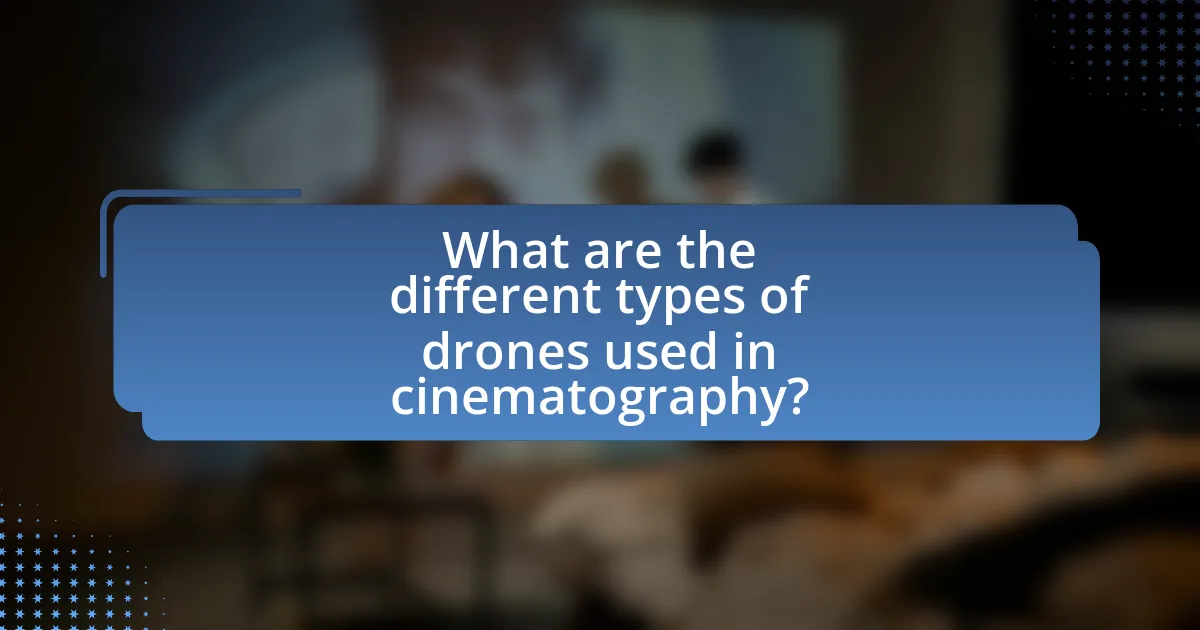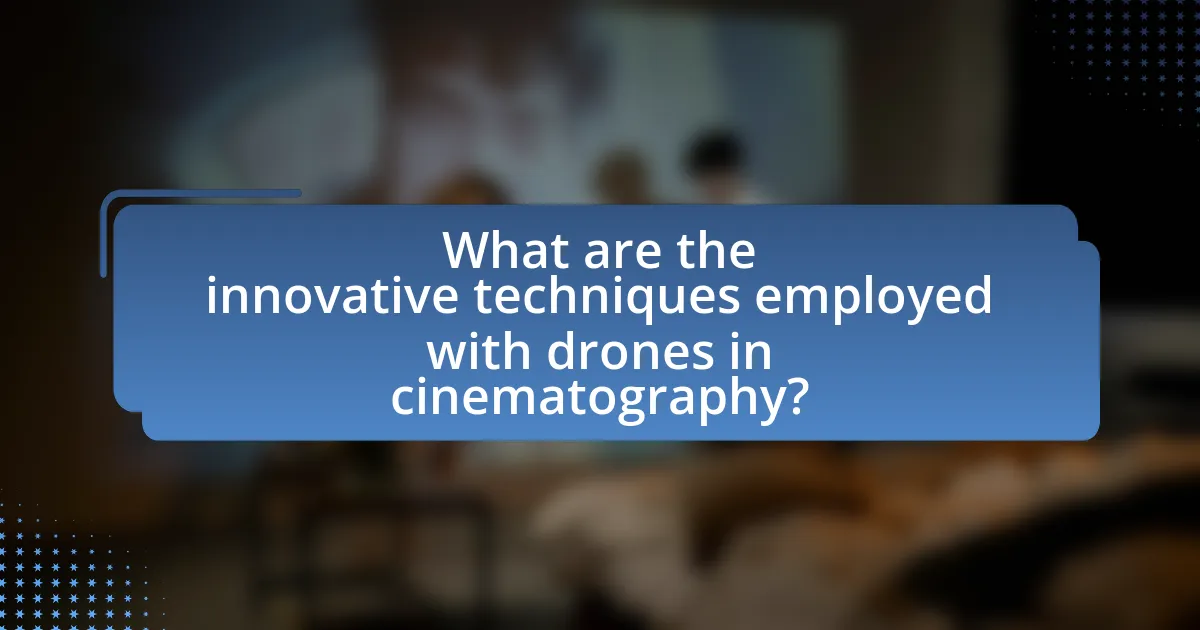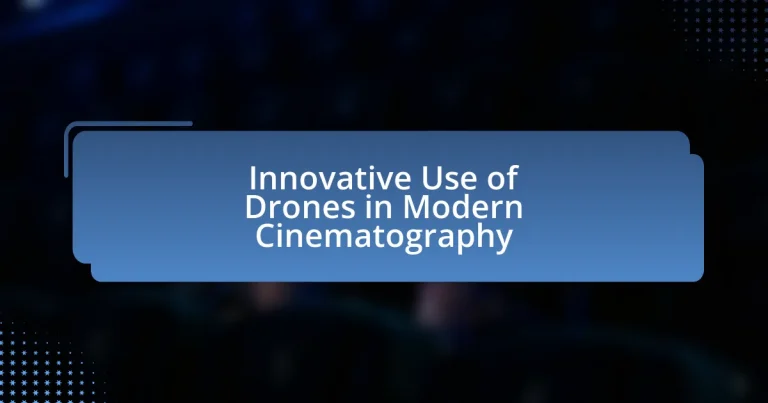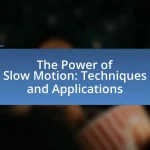The article focuses on the innovative use of drones in modern cinematography, highlighting their ability to capture aerial shots and dynamic perspectives that enhance storytelling and visual impact. It discusses how drones have transformed traditional cinematography practices by providing cost-effective solutions and unique filming capabilities, making high-quality aerial cinematography accessible to a wider range of filmmakers. Key topics include the advantages of drones over conventional methods, the types of drones used in cinematography, safety regulations, and best practices for ensuring high-quality footage. The article also explores the challenges filmmakers face when using drones and offers troubleshooting tips and techniques for successful integration into film production.

What is the Innovative Use of Drones in Modern Cinematography?
The innovative use of drones in modern cinematography involves capturing aerial shots and dynamic perspectives that were previously difficult or impossible to achieve. Drones enable filmmakers to obtain high-quality footage from unique angles, enhancing storytelling and visual impact. For instance, films like “The Revenant” utilized drone technology to create sweeping landscapes and immersive scenes, showcasing the versatility and efficiency of drones in production. Additionally, the use of drones reduces costs associated with traditional aerial filming methods, such as helicopters, while providing filmmakers with greater creative freedom and flexibility in shooting locations.
How have drones transformed traditional cinematography practices?
Drones have transformed traditional cinematography practices by enabling filmmakers to capture aerial shots and dynamic movements that were previously difficult or impossible to achieve. This innovation allows for unique perspectives and expansive views, enhancing storytelling and visual engagement. For instance, the use of drones in films like “The Avengers” and “Game of Thrones” has demonstrated their capability to create sweeping landscape shots and intricate action sequences, which significantly elevate production value. Additionally, drones reduce costs associated with helicopter rentals and large crew setups, making high-quality aerial cinematography more accessible to independent filmmakers and smaller productions.
What specific capabilities do drones bring to cinematography?
Drones bring specific capabilities to cinematography, including aerial shots, dynamic movement, and cost-effective filming. Aerial shots allow filmmakers to capture expansive landscapes and unique perspectives that traditional cameras cannot achieve. Dynamic movement enables smooth tracking shots and complex maneuvers, enhancing storytelling through visual engagement. Cost-effective filming reduces the need for expensive equipment like cranes or helicopters, making high-quality aerial cinematography accessible to a broader range of filmmakers. These capabilities have transformed the industry, as evidenced by the increasing use of drones in major film productions and documentaries, where they provide innovative visual storytelling techniques.
How do drones enhance visual storytelling in film and video production?
Drones enhance visual storytelling in film and video production by providing unique aerial perspectives that were previously difficult or impossible to achieve. These unmanned aerial vehicles allow filmmakers to capture sweeping landscapes, dynamic tracking shots, and intricate movements that add depth and context to the narrative. For instance, the use of drones in films like “The Revenant” has demonstrated their ability to create immersive environments, showcasing vast terrains and enhancing the emotional impact of scenes. Additionally, drones can operate in tight spaces and navigate complex environments, offering creative flexibility that traditional camera rigs cannot match. This capability not only elevates the visual quality but also engages audiences more effectively, making the storytelling experience richer and more compelling.
Why are drones becoming essential tools for filmmakers?
Drones are becoming essential tools for filmmakers due to their ability to capture dynamic aerial shots and unique perspectives that were previously difficult or expensive to achieve. This capability allows filmmakers to enhance storytelling by providing visually stunning imagery, which can significantly elevate the production value of films. For instance, a study by the American Film Institute highlights that the use of drones in cinematography has increased by over 300% in the past five years, demonstrating their growing importance in the industry.
What advantages do drones offer over conventional filming methods?
Drones offer significant advantages over conventional filming methods, primarily through their ability to capture dynamic aerial shots and access hard-to-reach locations. Unlike traditional cameras mounted on cranes or helicopters, drones provide a cost-effective solution for aerial cinematography, allowing filmmakers to achieve high-quality footage without the need for extensive equipment or crew. For instance, drones can fly at various altitudes and angles, enabling unique perspectives that enhance storytelling. Additionally, advancements in drone technology, such as stabilization systems and high-resolution cameras, ensure smooth and professional-grade footage, which is crucial for modern cinematography.
How do drones improve accessibility to challenging filming locations?
Drones improve accessibility to challenging filming locations by enabling filmmakers to capture aerial footage in areas that are difficult to reach on foot or with traditional equipment. Their ability to fly over rugged terrain, dense forests, or steep cliffs allows for unique perspectives and shots that would otherwise be impossible or dangerous to obtain. For instance, drones can easily navigate tight spaces and high altitudes, providing filmmakers with the flexibility to shoot in remote locations without the need for extensive ground support or heavy equipment. This capability is supported by advancements in drone technology, such as enhanced battery life and high-resolution cameras, which facilitate high-quality filming in previously inaccessible areas.

What are the different types of drones used in cinematography?
The different types of drones used in cinematography include multi-rotor drones, fixed-wing drones, and hybrid drones. Multi-rotor drones, such as quadcopters, are popular for their stability and maneuverability, making them ideal for capturing dynamic shots. Fixed-wing drones are used for longer flight times and covering larger areas, suitable for landscape cinematography. Hybrid drones combine features of both multi-rotor and fixed-wing designs, offering versatility in various filming scenarios. These classifications are supported by industry practices, where filmmakers select drone types based on specific project requirements, such as shot complexity and flight duration.
How do various drone models cater to different filming needs?
Various drone models cater to different filming needs by offering unique features tailored to specific cinematographic requirements. For instance, high-end drones like the DJI Inspire 2 provide advanced stabilization and high-resolution cameras, making them ideal for professional filmmakers who need cinematic quality and smooth footage. In contrast, smaller drones such as the DJI Mini 2 are lightweight and portable, catering to hobbyists or travel filmmakers who prioritize convenience and ease of use without sacrificing decent image quality. Additionally, specialized drones equipped with thermal imaging cameras serve niche markets like search and rescue operations, demonstrating how diverse functionalities meet varied filming demands.
What features should filmmakers consider when choosing a drone?
Filmmakers should consider camera quality, flight time, stability, and ease of use when choosing a drone. High-resolution cameras, such as those capable of shooting 4K or higher, ensure that the footage meets professional standards. Flight time is crucial; drones with longer battery life, typically around 20-30 minutes, allow for extended shooting sessions without frequent interruptions. Stability features, including gimbal stabilization, are essential for capturing smooth, professional-looking shots, especially in windy conditions. Lastly, user-friendly controls and software can significantly enhance the filming experience, making it easier for filmmakers to focus on creativity rather than technical difficulties.
Which drone brands are leading the market in cinematography?
The leading drone brands in the cinematography market are DJI, Parrot, and Autel Robotics. DJI dominates the market with its Inspire and Mavic series, which are widely recognized for their advanced camera capabilities and stability, making them preferred choices for filmmakers. Parrot offers the Anafi series, known for its lightweight design and 4K HDR video quality, appealing to both professionals and enthusiasts. Autel Robotics, with its EVO series, provides competitive features such as 4K video and long flight times, gaining traction among cinematographers. These brands are validated by their significant market share and positive reviews from industry professionals, highlighting their reliability and performance in cinematic applications.
What regulations and safety measures must be followed when using drones?
When using drones, operators must adhere to regulations set by aviation authorities, such as the Federal Aviation Administration (FAA) in the United States, which mandates that drones must be flown below 400 feet, within the operator’s line of sight, and not over people or moving vehicles. Additionally, operators are required to register their drones if they weigh more than 0.55 pounds and must obtain a Remote Pilot Certificate if flying for commercial purposes. Safety measures include conducting pre-flight checks, ensuring the drone is in good working condition, and being aware of local airspace restrictions and no-fly zones, which are often outlined in the FAA’s B4UFLY app. These regulations and safety measures are crucial for minimizing risks and ensuring safe drone operations in cinematography.
How do local laws impact drone usage in film production?
Local laws significantly impact drone usage in film production by establishing regulations that filmmakers must adhere to for safety and compliance. These laws can dictate where drones can be flown, often restricting operations near airports, populated areas, or sensitive locations, which can limit filming opportunities. For instance, the Federal Aviation Administration (FAA) in the United States requires drone operators to obtain specific licenses and permits, ensuring that they follow guidelines for altitude, airspace, and operational safety. Violating these regulations can result in fines or legal action, emphasizing the importance of understanding local laws for successful drone integration in cinematography.
What safety protocols should filmmakers implement when operating drones?
Filmmakers should implement several safety protocols when operating drones, including conducting pre-flight checks, ensuring compliance with local regulations, and maintaining a safe distance from people and property. Pre-flight checks involve inspecting the drone’s battery, propellers, and camera equipment to ensure everything is functioning correctly, which reduces the risk of malfunctions during flight. Compliance with local regulations, such as obtaining necessary permits and adhering to no-fly zones, is crucial for legal operation and safety. Maintaining a safe distance from crowds and obstacles minimizes the risk of accidents and injuries, as drones can cause harm if they crash or collide with individuals or structures. These protocols are essential for safe drone operation in cinematography, as evidenced by the increasing number of regulations established by aviation authorities worldwide to ensure public safety.

What are the innovative techniques employed with drones in cinematography?
Innovative techniques employed with drones in cinematography include aerial tracking shots, dynamic camera movements, and high-resolution imaging capabilities. Aerial tracking shots allow filmmakers to capture sweeping landscapes and action sequences from unique angles, enhancing storytelling. Dynamic camera movements, facilitated by drone agility, enable seamless transitions and fluid motion that traditional equipment cannot achieve. High-resolution imaging capabilities, often exceeding 4K, provide filmmakers with exceptional detail and clarity, making drone footage suitable for high-end productions. These techniques have revolutionized cinematography by offering creative flexibility and cost-effective solutions for capturing complex shots.
How do filmmakers utilize drones for unique shot compositions?
Filmmakers utilize drones to achieve unique shot compositions by capturing aerial perspectives and dynamic movements that traditional cameras cannot. Drones enable filmmakers to create sweeping landscape shots, intricate tracking shots, and high-angle views, enhancing storytelling through visual variety. For instance, the film “The Revenant” employed drone technology to capture expansive wilderness scenes, showcasing the environment’s scale and beauty, which would be difficult to replicate with ground-based equipment. This innovative approach allows for greater creativity and flexibility in cinematography, making drones an essential tool in modern filmmaking.
What are some examples of creative drone shots in recent films?
Recent films have showcased creative drone shots that enhance storytelling and visual appeal. For instance, “1917” features sweeping aerial shots that capture the vastness of the battlefield, providing a unique perspective on the war setting. In “The Lion King,” drone technology was used to create stunning landscape shots that mimic the natural movements of wildlife, adding depth to the animated scenes. Additionally, “The Invisible Man” employs drone shots to build tension, using overhead views to create a sense of isolation and vulnerability for the characters. These examples illustrate how filmmakers are leveraging drone technology to push the boundaries of traditional cinematography.
How can drones be integrated with other filming technologies?
Drones can be integrated with other filming technologies by utilizing them alongside traditional cameras, stabilizers, and software for enhanced cinematography. For instance, drones equipped with high-definition cameras can capture aerial shots that complement ground-level footage from DSLRs or cinema cameras, creating a dynamic visual narrative. Additionally, integrating drones with gimbals ensures stable footage during flight, while software like Adobe Premiere Pro allows for seamless editing of drone footage with other filmed content. This integration enhances storytelling by providing diverse perspectives and improving production value, as evidenced by films like “The Revenant,” which employed drone technology for breathtaking aerial scenes.
What challenges do filmmakers face when using drones?
Filmmakers face several challenges when using drones, including regulatory restrictions, technical limitations, and safety concerns. Regulatory restrictions often require filmmakers to obtain permits and adhere to specific guidelines set by aviation authorities, which can vary by location and may limit where and when drones can be flown. Technical limitations include battery life and payload capacity, which can restrict flight duration and the types of cameras that can be used. Safety concerns arise from the risk of accidents, such as collisions with people or property, necessitating careful planning and risk assessment to ensure safe operation. These challenges can impact the efficiency and feasibility of drone usage in film production.
How can filmmakers overcome technical limitations of drones?
Filmmakers can overcome technical limitations of drones by utilizing advanced stabilization technology and optimizing flight planning. Advanced stabilization systems, such as gimbals, enhance the quality of aerial shots by reducing vibrations and ensuring smooth footage, which is crucial for cinematic storytelling. Additionally, meticulous flight planning, including pre-programmed flight paths and altitude adjustments, allows filmmakers to capture complex shots while adhering to safety regulations and maximizing battery life. These strategies have been validated by numerous successful film projects that have effectively integrated drone technology, demonstrating that careful preparation and the right equipment can significantly mitigate the inherent limitations of drone cinematography.
What are common troubleshooting tips for drone cinematography?
Common troubleshooting tips for drone cinematography include checking battery levels, ensuring GPS signal strength, and calibrating the drone’s compass. Low battery levels can lead to unexpected flight behavior, while a weak GPS signal may result in loss of control. Calibrating the compass before each flight helps maintain accurate positioning and stability. Additionally, inspecting propellers for damage and ensuring firmware is up to date can prevent mechanical failures and improve performance. These practices are essential for achieving high-quality aerial footage and ensuring safe operation.
What best practices should filmmakers follow when using drones?
Filmmakers should prioritize safety, compliance with regulations, and effective planning when using drones. Safety involves conducting thorough pre-flight checks, ensuring the drone is in good working condition, and being aware of the surroundings to avoid accidents. Compliance with regulations includes obtaining necessary permits and adhering to local laws regarding drone usage, such as altitude limits and no-fly zones. Effective planning entails scouting locations in advance, considering weather conditions, and creating a detailed shot list to maximize efficiency during filming. These practices are essential for successful drone operation in cinematography, as they help mitigate risks and enhance the quality of aerial footage.
How can filmmakers ensure high-quality footage with drones?
Filmmakers can ensure high-quality footage with drones by utilizing advanced stabilization technology and high-resolution cameras. Advanced stabilization systems, such as gimbals, minimize vibrations and jerky movements, resulting in smoother footage. High-resolution cameras, often capable of shooting in 4K or higher, capture more detail and provide greater flexibility in post-production. Additionally, filmmakers should conduct thorough pre-flight planning, including checking weather conditions and understanding the drone’s capabilities, to optimize shooting conditions. According to a study by the Academy of Motion Picture Arts and Sciences, drones equipped with high-quality cameras and stabilization systems significantly enhance the visual quality of aerial shots, making them a valuable tool in modern cinematography.
What are the key considerations for planning a drone shoot?
Key considerations for planning a drone shoot include understanding local regulations, selecting the appropriate equipment, and conducting a thorough site assessment. Local regulations dictate where and how drones can be operated, including altitude limits and no-fly zones, which are crucial for legal compliance. Choosing the right drone and camera setup is essential for achieving desired cinematic effects, as different drones offer varying capabilities in terms of stability, flight time, and camera quality. A site assessment helps identify potential obstacles, optimal flight paths, and lighting conditions, ensuring that the shoot runs smoothly and captures the intended visuals effectively.


